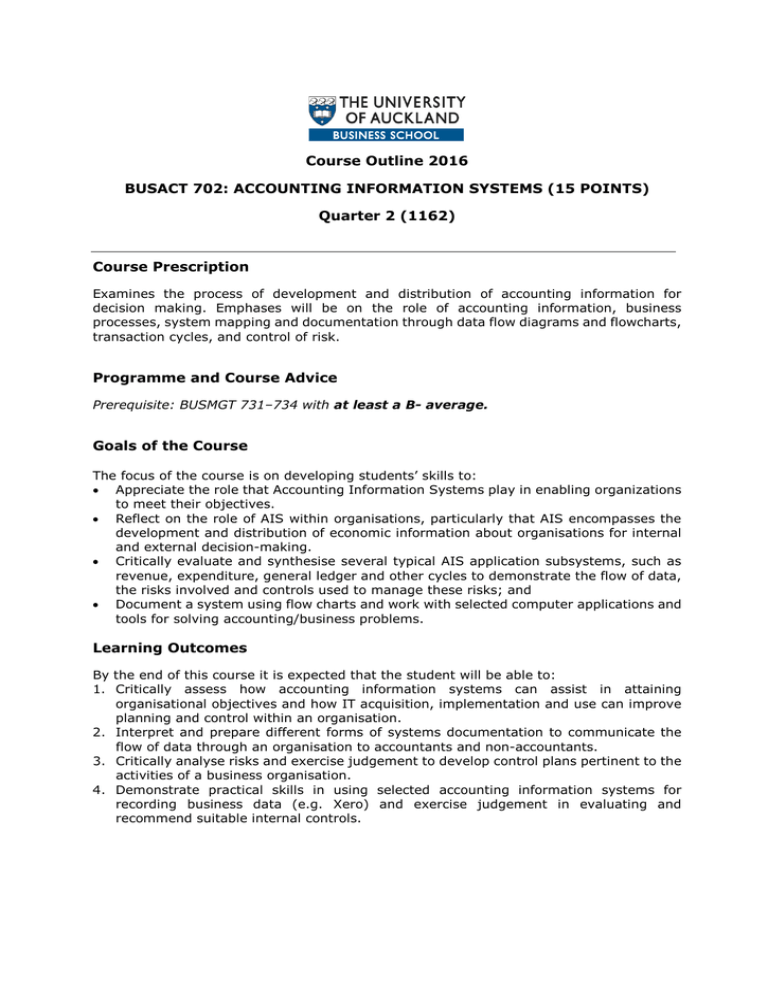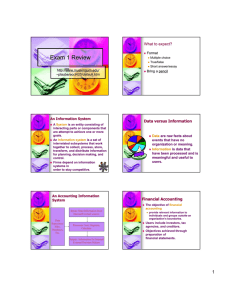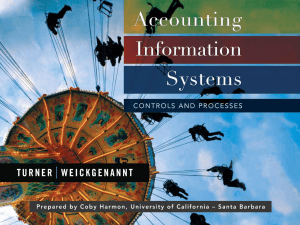Course Outline 2016 BUSACT 702: ACCOUNTING INFORMATION SYSTEMS (15 POINTS)
advertisement

Course Outline 2016 BUSACT 702: ACCOUNTING INFORMATION SYSTEMS (15 POINTS) Quarter 2 (1162) Course Prescription Examines the process of development and distribution of accounting information for decision making. Emphases will be on the role of accounting information, business processes, system mapping and documentation through data flow diagrams and flowcharts, transaction cycles, and control of risk. Programme and Course Advice Prerequisite: BUSMGT 731–734 with at least a B- average. Goals of the Course The focus of the course is on developing students’ skills to: • Appreciate the role that Accounting Information Systems play in enabling organizations to meet their objectives. • Reflect on the role of AIS within organisations, particularly that AIS encompasses the development and distribution of economic information about organisations for internal and external decision-making. • Critically evaluate and synthesise several typical AIS application subsystems, such as revenue, expenditure, general ledger and other cycles to demonstrate the flow of data, the risks involved and controls used to manage these risks; and • Document a system using flow charts and work with selected computer applications and tools for solving accounting/business problems. Learning Outcomes By the end of this course it is expected that the student will be able to: 1. Critically assess how accounting information systems can assist in attaining organisational objectives and how IT acquisition, implementation and use can improve planning and control within an organisation. 2. Interpret and prepare different forms of systems documentation to communicate the flow of data through an organisation to accountants and non-accountants. 3. Critically analyse risks and exercise judgement to develop control plans pertinent to the activities of a business organisation. 4. Demonstrate practical skills in using selected accounting information systems for recording business data (e.g. Xero) and exercise judgement in evaluating and recommend suitable internal controls. Content Outline Week 1 Introduction to Accounting Information Systems Introduction to Business Processes and Documenting Systems - Dataflow Diagrams and Systems and Document Flow charts Week 2 Business Processes and Documenting Systems - Dataflow Diagrams and - Systems and Document Flow charts Week 3 Documenting Systems continued - Dataflow Diagrams Week 4 Documenting Systems continued - Systems and Document Flowcharts Week 5 Information System Controls/Accounting Information System Cycles - Revenue Week 6 Information Systems Controls/Accounting Information System Cycles - Expenditure and Other Cycles Week 7 Relational Databases/Structured Query Language (SQL) Week 8 Information Technology/Fraud and Cybercrime Week 9 Systems Development and Procurement Week 10 Review and Final Test Learning and Teaching The class will meet for: • One and a half hours as a lecture. • Two hours in a TBL environment. • Two hours in a computer lab workshop. Staff office hours will also be available each week for individual assistance. In addition to attending classes, students should be prepared to spend about ten hours per week on activities related to this course. These activities include reading the textbook, solving recommended practice problems, preparing for workshops, working on assignments and preparing for the test. Teaching Staff Lecturer: Dr Karin Olesen Tutor: Claris Chung Learning Resources The required textbook for this course is: Accounting Information Systems: Understanding Business Processes, 4th Edition Brett Considine, Alison Parkes, Karin Olesen, Yvette Blount, Derek Speer June 2012, ©2012Wiley Australia. ISBN: 978-0-7303-2504-8 Any additional course materials (e.g. case studies) will be provided. Assessment Assignment 20% In-class assessment (7 at 2% each) 14% Computer-based practical test 16% Final test 50% Total 100% The broad relationship between these assessments and the course learning outcomes is as follows: Learning Outcome Assignments Quizzes 1 X X X 2 X X X 3 X X X 4 Practical Test X Final Test Inclusive Learning Students are urged to privately discuss any impairment-related requirements in person and/or in written form with the course convenor/lecturer and/or tutor. Student Feedback The course is designed based on prior experience of designing and delivering management courses. Formal feedback will be sought about your experience towards the end of the course and fast feedback will be sought during the quarter. Any other feedback about the course can be given to the lecturer.





